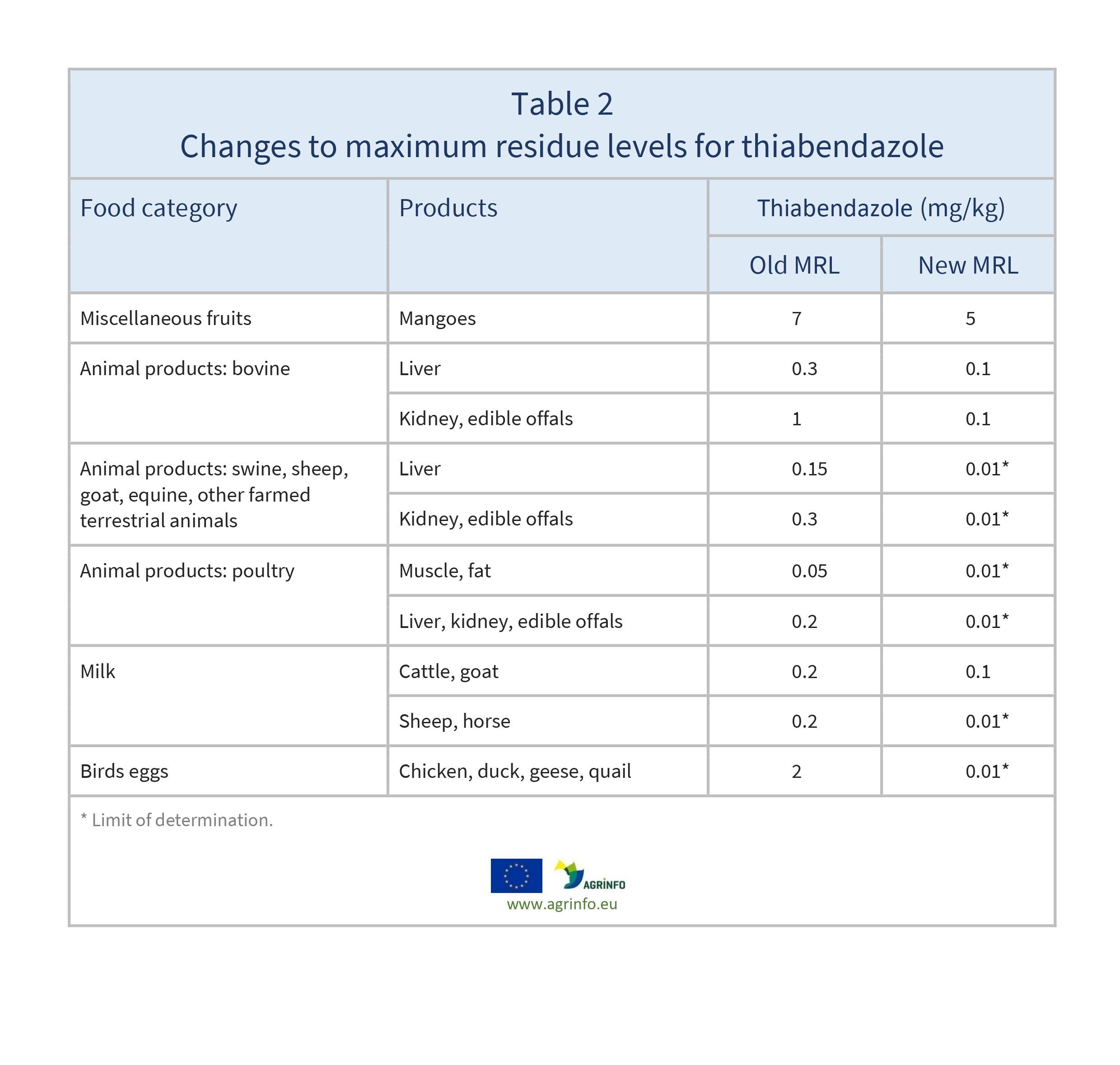Maximum residue levels for thiabendazole
- Pesticide MRLs
Summary
The European Commission is reducing the maximum residue levels (MRLs) for thiabendazole on avocados and papayas. This follows earlier reductions to the MRLs for this substance on mangoes and animal products, which have applied since September 2023.
EU lowers MRLs for thiabendazole on avocados and papayas
Commission Regulation (EU) 2024/1342 of 21 May 2024 amending Annex II to Regulation (EC) No 396/2005 of the European Parliament and of the Council as regards maximum residue levels for deltamethrin, metalaxyl, thiabendazole and trifloxystrobin in or on certain products
Corrigendum to Commission Regulation (EU) 2024/1342 of 21 May 2024 amending Annex II to Regulation (EC) No 396/2005 of the European Parliament and of the Council as regards maximum residue levels for deltamethrin, metalaxyl, thiabendazole and trifloxystrobin in or on certain products
Commission Regulation (EU) 2023/377 of 15 February 2023 amending Annexes II, III, IV and V to Regulation (EC) No 396/2005 of the European Parliament and of the Council as regards maximum residue levels for benzalkonium chloride (BAC), chlorpropham, didecyldimethylammonium chloride (DDAC), flutriafol, metazachlor, nicotine, profenofos, quizalofop-P, sodium aluminium silicate, thiabendazole and triadimenol in or on certain products
Update
The European Commission is reducing the maximum residue levels (MRLs) for thiabendazole on avocados and papayas. This follows earlier reductions to the MRLs for this substance on mangoes and animal products, which have applied since September 2023.
Impacted Products
mangoes, milk, eggs, animal products, avocados, papayas
What is changing?
The recent reductions to thiabendazole MRLs on avocados and papayas are set out in Table 1.
The reductions to thiabendazole MRLs that have applied from September 2023 are shown in Table 2.
In addition, the limit of determination (LOD) for all muscle and fat products from swine/ sheep/ equine/ other farmed terrestrial animals, except bovine and goat, is reduced to 0.01 mg/kg. (The LOD is the lowest level that can be detected using the most modern and reliable analytical methods.)
Why?
EFSA (2022) has concluded that to ensure consumer safety, the MRL for avocados should be reduced. EFSA also identified a potential risk for consumers regarding the existing MRL for papayas, and stated that this MRL should be lowered to the LOD.
Timeline
The changes to MRLs on avocados and papayas apply from 11 December 2024. Avocados exported before 11 December 2024 that comply with the old MRLs will not be removed from the EU market after that date, even if they do not comply with the new MRLs.
The MRLs for thiabendazole set out in Table 2 (Regulation 2023/377) have applied from 14 September 2023.
Recommended Actions
Suppliers of avocados should review their use of thiabendazole and assess whether any changes will be needed to existing good agricultural practices (GAP). Suppliers of papayas should look for possible alternative solutions.
Background
MRLs are set in accordance with the rules set out in Regulation 396/2005. For information on current MRLs for other substances, please consult the EU Pesticide Residues database.
Resources
EFSA (2022) Evaluation of confirmatory data following the Article 12 MRL review for thiabendazole. EFSA Journal, 20(8): 7539.
Sources
Commission Regulation (EU) 2024/1342 as regards maximum residue levels for deltamethrin, metalaxyl, thiabendazole and trifloxystrobin in or on certain products
Commission Regulation (EU) 2023/377 as regards maximum residue levels for benzalkonium chloride (BAC), chlorpropham, didecyldimethylammonium chloride (DDAC), flutriafol, metazachlor, nicotine, profenofos, quizalofop-P, sodium aluminium silicate, thiabendazole and triadimenol in or on certain products
Disclaimer: Under no circumstances shall COLEAD be liable for any loss, damage, liability or expense incurred or suffered that is claimed to have resulted from the use of information available on this website or any link to external sites. The use of the website is at the user’s sole risk and responsibility. This information platform was created and maintained with the financial support of the European Union. Its contents do not, however, reflect the views of the European Union.
EU lowers MRLs for thiabendazole on avocados and papayas
Commission Regulation (EU) 2024/1342 as regards maximum residue levels for deltamethrin, metalaxyl, thiabendazole and trifloxystrobin in or on certain products
Commission Regulation (EU) 2023/377 as regards maximum residue levels for benzalkonium chloride (BAC), chlorpropham, didecyldimethylammonium chloride (DDAC), flutriafol, metazachlor, nicotine, profenofos, quizalofop-P, sodium aluminium silicate, thiabendazole and triadimenol in or on certain products
What is changing and why?
Reductions to maximum residue levels (MRLs) for thiabendazole on avocados and papayas are set out in Table 1.
Reductions to thiabendazole MRLs that have applied since September 2023 are shown in Table 2.
This is in response to potential risks identified by the European Food Safety Authority.
Actions
Suppliers of avocados should review their use of thiabendazole and assess whether any changes will be needed to existing good agricultural practices (GAP). Suppliers of papayas should look for possible alternative solutions.
Timeline
New MRLs for thiabendazole (in Regulation 2023/377) have applied from 14 September 2023.
The changes to MRLs on avocados and papayas apply from 11 December 2024. Avocados exported before 11 December 2024 that comply with the old MRLs will not be removed from the EU market after that date, even if they do not comply with the new MRLs.
Tables & Figures
Disclaimer: Under no circumstances shall COLEAD be liable for any loss, damage, liability or expense incurred or suffered that is claimed to have resulted from the use of information available on this website or any link to external sites. The use of the website is at the user’s sole risk and responsibility. This information platform was created and maintained with the financial support of the European Union. Its contents do not, however, reflect the views of the European Union.


